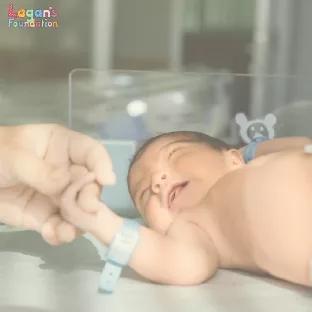Understanding Total Anomalous Pulmonary Venous Return [TAPVR]
Total Anomalous Pulmonary Venous Return is a rare heart defect that is present at birth and it occurs when pulmonary veins connect to the heart in an abnormal way.
Children born with this condition will need surgery to repair the defect, as well routine checkups to stay as healthy as possible as they grow.
What is Total Anomalous Pulmonary Venous Return (TAPVR) in children?
Total Anomalous Pulmonary Venous Return (TAPVR) is a congenital heart defect that affects the pulmonary veins.
In a healthy heart, the pulmonary veins carry oxygen-rich blood from the lungs to the left atrium. With TAPVR, the pulmonary veins drain into the wrong part of the heart (an anomalous connection), resulting in oxygen-rich and oxygen-poor blood mixing.
This abnormal connection means that oxygen-rich blood is not delivered to the left side of the body or pumped around correctly.
The different types of Total Anomalous Pulmonary Venous Return
There are three types of TAPVR and what defines them is based on where the pulmonary veins connect:
- Supercardiac – In Supercardiac TAPVR, the pulmonary veins come together and form an abnormal connection above the heart to the superior vena cava, which is the main blood vessel. The vena cava brings oxygen-poor blood from the upper part of the body to the heart.
In Supercardiac TAPVR, the vena cava brings a mixture of oxygen-rich and oxygen-poor blood back to the right atrium.
- Cardiac – In cardiac TAPVR, the pulmonary veins meet behind the heart and connect to the right atrium. The coronary sinus is a vein that helps to return oxygen-poor blood from the heart back to itself in the right atrium.
In this type of TAPVR, the coronary sinus helps to connect the pulmonary veins to the right atrium.
- Infracardiac – In this type of TAPVR, the pulmonary veins come together and form an abnormal connection below the heart. This connection causes oxygen-rich and oxygen-poor blood to return to the right atrium from the liver and the superior vena cava.
The inferior vena cava is the main vessel that brings oxygen-poor blood from the lower body to the heart.
All types of TAPVR will typically be accompanied by an Atrial Septal Defect (ASD), which is a hole in the wall between the upper chambers of the heart. This hole allows some of the oxygen-rich blood from the right atrium to exit through the left atrium to the body.
Symptoms and diagnosis of Total Anomalous Pulmonary Venous Return
Symptoms of Total Anomalous Pulmonary Venous Return will usually occur immediately after birth or soon after. Infants with TAPVR will often have bluish looking skin, called cyanosis, because their blood doesn’t carry enough oxygen.
Other signs and symptoms can include:
- Difficulty breathing and making grunting sounds
- Retractions of the rib cage muscles
- Weak pulse
- Lack of growth or weight gain
- Problems feeding
- Extreme tiredness
- Heart murmurs
How is Total Anomalous Pulmonary Venous Return treated?
All types of Total Anomalous Pulmonary Venous Return will need to be treated with surgery, but the timing of the surgery will depend on the type of TAPVR present.
Newborns who have an obstructed TAPVR will need surgery immediately after birth. Some infants may also need extracorporeal life support (ECMO) prior to surgery to help stabilise their blood flow. During surgery, the ASD will also be repaired.
Infants with an unobstructed TAPVR will typically have surgery days to weeks after the diagnosis is made. In children who have an ASD that is not big enough to let blood flow through to the left side, a balloon dilation procedure may be completed prior to surgery to improve the child’s condition.
During surgery, the surgeon will connect all of the veins to the back of the left atrium in order to create a normal connection of the pulmonary veins to the left atrium. All other routes for the pulmonary venous drainage are tied off.
Are there possible complications of TAPVR?
There are a few possible complications of Total Anomalous Pulmonary Venous Return if the condition is left untreated or not managed appropriately:
- Enlarged heart
- Lung problems
- Abnormal heart rhythms, known as arrhythmia
- Heart failure
- Slowed growth and development
- Enlarged liver
- Infection
- Death
Your child and living with Total Anomalous Pulmonary Venous Return
The outcome for surgical repair of Total Anomalous Pulmonary Venous Return is extremely positive, with many infants growing and developing as normal after all surgery and aftercare is completed.
Although not impossible, it is also rare for children to develop complications related to TAPVR late after surgery. However, regular follow-up appointments with your child’s cardiologist are essential for spotting these problems early on.
Your child may also need the following care as they grow:
- More surgeries and cardiac catheterisation
- Antibiotics before other surgeries or dental procedures to prevent infections
Extra support if they have delayed development
How we support children with TAPVR and their parents
At Lagan’s Foundation, we provide respite care and short break services for children with Total Anomalous Pulmonary Venous Return and their families.
We know caring for children with complex needs is challenging, which is why we are here to help. Our purpose is to provide unique at home and in hospital care to help support families and give them a much needed break.
If you have a child that suffers from a congenital heart defect, such as TAPVR, feel free to get in touch with our friendly team today to find out more on how we can provide the help and support you may need.




